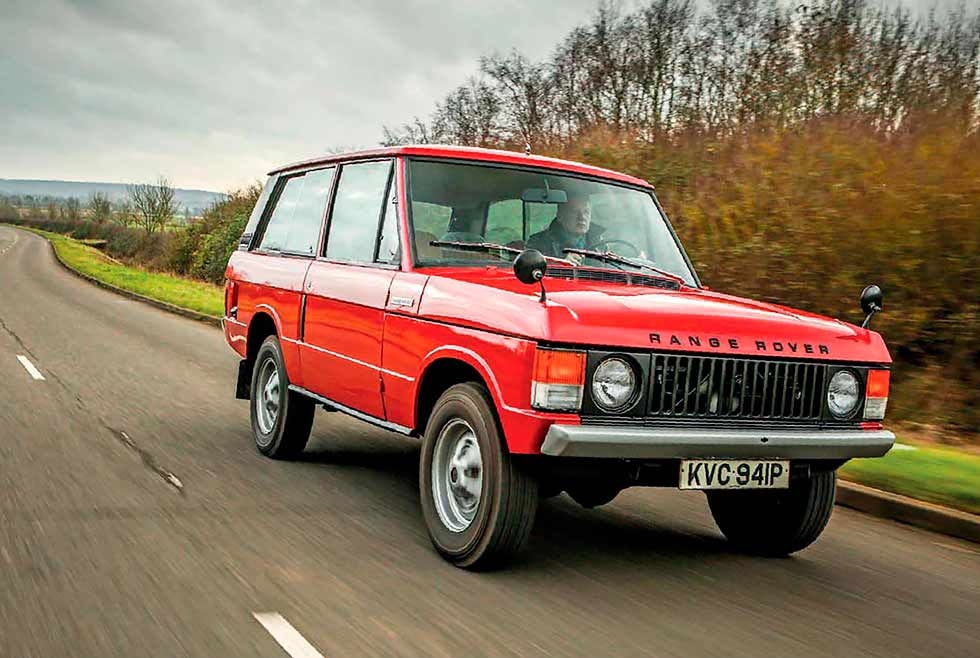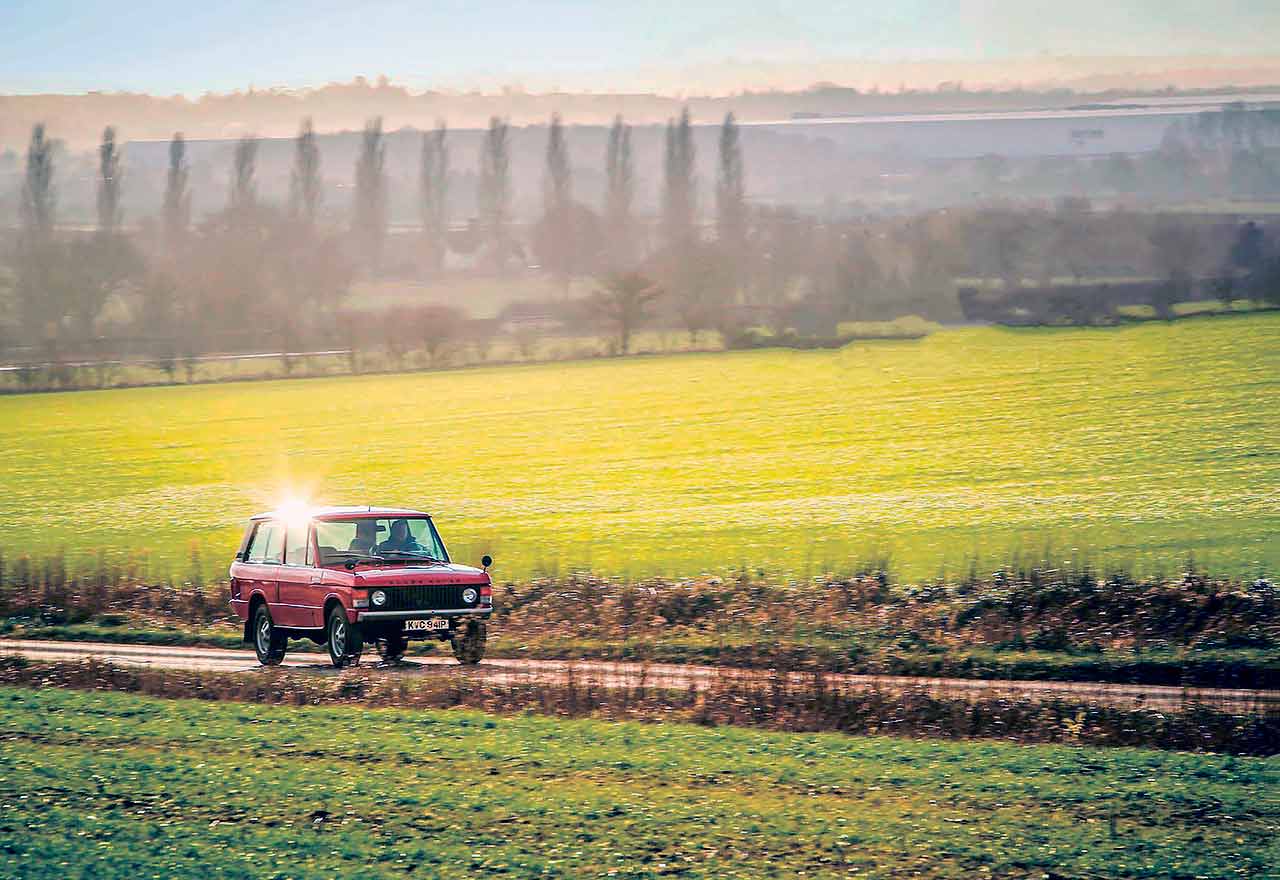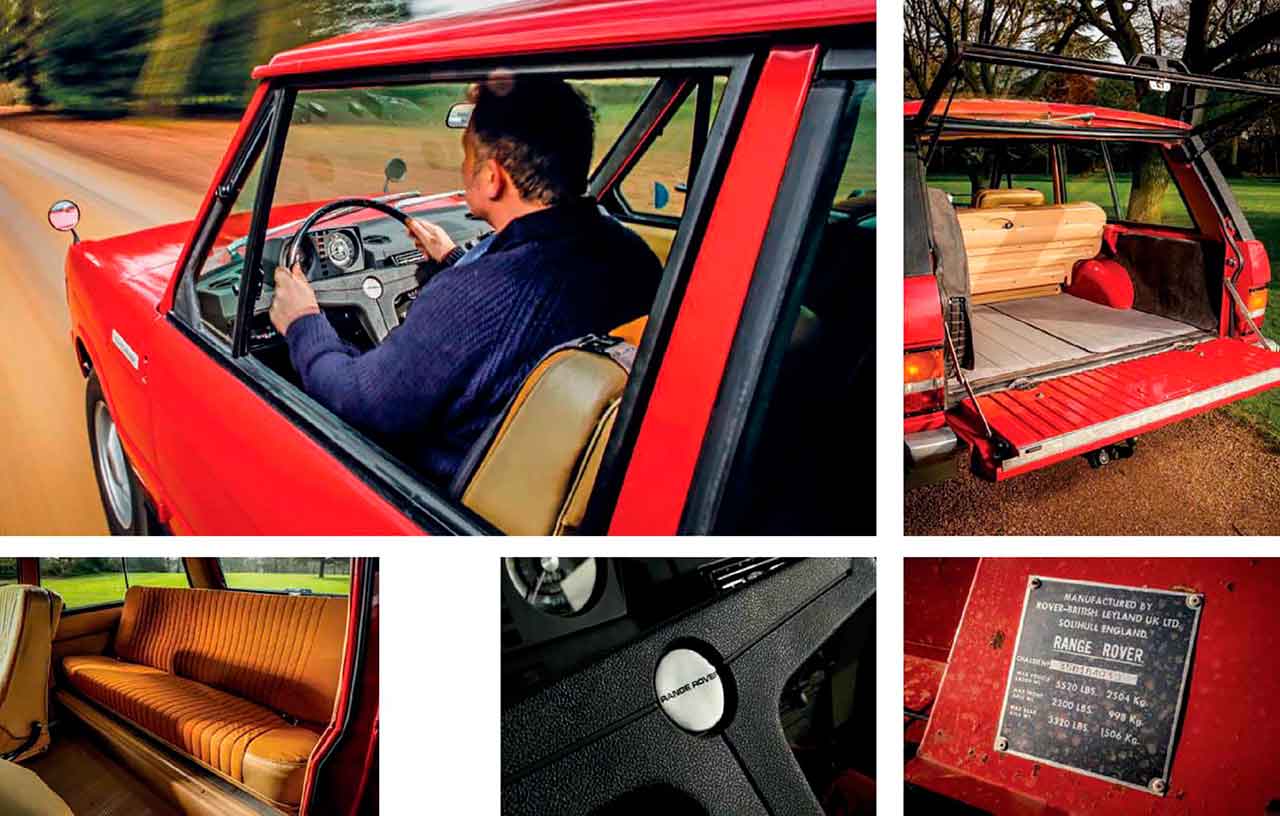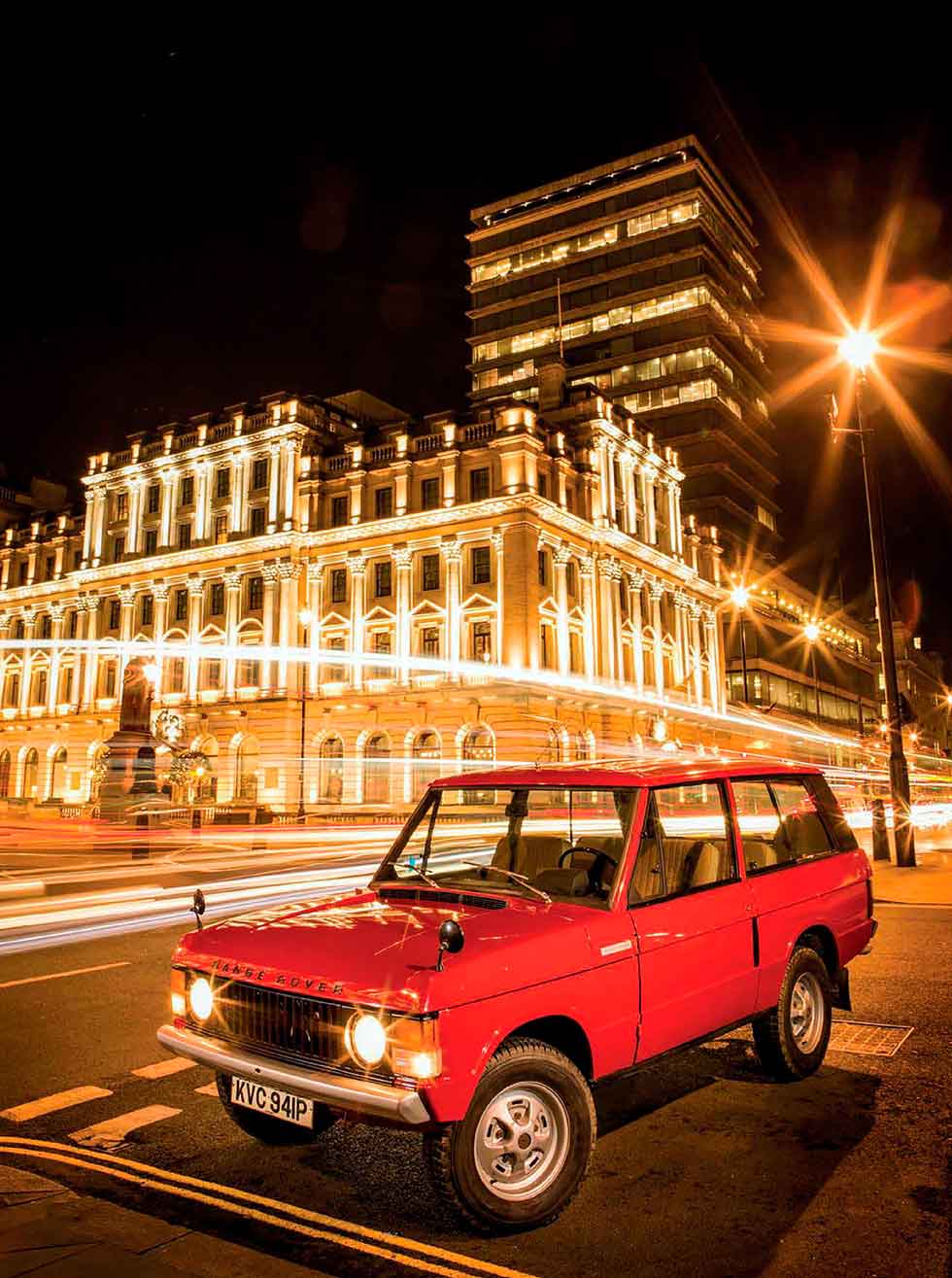
Britain’s top all-rounder Range Rover celebrated. Town & Country. The ground-breaking Range Rover boasted a supreme range of abilities, explains Martin Buckley as he reflects on its legacy. Photography Tony Baker.
From rural lanes to city streets, the Range Rover is the only car you need. Solihull’s 4×4 sensation. Rediscovering the brilliant Rangie.
For once, Lord Stokes got it right. Had the Leyland boss and his usually bungling cohorts not recognised the possibilities of the Range Rover concept in the late 1960s, the idea of a luxurious, multi-purpose off-road car might have been left to another manufacturer to exploit. It is to his rare credit that Stokes saw the Range Rover – its basics largely settled by 1967 – as a great way for his giant conglomerate to kick off the following decade, alongside the Stag.
With no new mainstream offering to highlight (the dismal Marina would not be ready until 1971), Stokes insisted that it was pushed through to a 1970 introduction. It’s hard to reconcile the abilities of the Range Rover with the Maxis and Marinas of this world, but it came from the same stable and is one of the very few positive legacies of the early ’70s BL regime.

If the poor old Stag was a frustrating cul-desac, the Range Rover was nothing less than a moment of inspired genius. Outwardly, it was a simple, elegant, aluminium-panelled estate car that sat high on a rugged chassis, its solid axles softly sprung for on-road comfort and off-road articulation. Chunky and commanding, with massively deep windows, it took the French to recognise its visual brilliance by giving it a place in the Louvre as ‘an outstanding example of modern industrial design’.
Rover’s chief stylist David Bache was justifiably proud of that accolade. What was less well known at the time, however, was that the multitalented Spen King had got the basic shape pretty much spot-on at the prototype stage, leaving Bache to tidy up the presentation with those famous doorhandles and flush lights.
Yet somehow it wouldn’t have looked so good had we not known how good it was underneath, too, with permanent four-wheel drive and refined, flexible V8 power going through a specially created four-speed gearbox. With high and low ranges, locking differentials and longtravel coil springs, the Range Rover set new standards off-road – and created a furore on it.
In fact, it was quite a long time before Leyland and Rover fully understood exactly who was going to buy such a vehicle beyond gentleman farmers, the police and possibly the military. They had a hunch it would sell quite well, but not that it would become the overwhelming success it turned out to be; a new kind of sexy suburban status symbol, ‘lifestyle’ accessory and one of the great ‘must have’ cars of the time.
If you were around in the 1970s and had any awareness of cars, the Range Rover was a rare British success story in a period that offered little good news from our motor industry. Its classleading excellence was seemingly unchallenged, its desirability on a par with all kinds of exotica.
In its original two-door form, the Range Rover out-cooled the Scimitar GTEs and Triumph 2.5PI estates at the school gates with a functional elegance that seemed to promise adventure. It could go places other cars couldn’t – not even the macho pretenders to its crown from America, which were too big and nothing like as clever. It didn’t look out of place in any scenario, be it traversing the Darién Gap (it was the first car to do so in 1973) or pulling up with a discreet burble outside the Park Lane Hilton.
Somehow, no other model in history had managed that psychological leap. Rover called it four cars in one – a luxury car, a performance car, an estate car and a cross-country car, the implication being that, really, you didn’t need anything else. In fact, most buyers were well off and simply added their Range Rover to an existing stable of machinery.
It’s odd to reflect that the only major criticism anybody had of the Range Rover in those years was that it came as just a two-door. Today, it’s those basic old variants that everybody wants, the market’s taste piqued by the realisation that a high rate of attrition has made the early cars rare. The pre-production models (‘VELARs’) and other significant examples have long since breached the £100,000 mark if they are sufficiently mint, while the featured December 1975 left-hooker should command £60,000, according to its keeper, Chris Bishop.
I have to own up and say that I am a total Range Rover poseur. I’ve felt the occasional Callan-like urge to take mine off-piste but have always resisted it. The same goes for this Masai Red example – only more so given its value and originality. So, this is not a story about how I took to the hills, but more a tale of town and country, probably inspired by that evocative Range Rover launch film A Car for All Seasons. If you didn’t want a two-door before seeing that little gem, you will afterwards.
For me, the appeal of these things is in the sound, the driving position, the magnificent views out and to a certain extent the refinement – if you can put the noisy gearbox to one side.
The availability of that ex-Buick V8 was the great motivating spirit behind the project and enabled the Range Rover to square up to the American opposition (in the form of the Jeep Wagoneer and the International Harvester Scout), although it is strange that Leyland never quite managed to sell the early cars in the US.
In truth, the demand was so strong that it could not make enough for the home market and the Europeans. It seemed that for every naysayer who quietly pointed out that the Range Rover was really just a 15mpg, 100mph, four-wheel-drive estate car – grossly over-qualified for most buyers’ requirements – there were 10 or 20 eager purchasers brandishing deposits and desperately thinking of every reason in the world why they really needed a Range Rover in their lives.
At times, waiting lists were counted in years rather than months and there was a healthy profit to be made on delivery-mileage examples. At £2000, Leyland initially under-priced them. That the same car was £10,000 by the end of the decade was equally indicative of the inflation of the day as the fact that specification had become more luxurious. Options such as power steering and cloth seats were standardised.
Our featured example has both of those (as well as air-conditioning, a factory tow bar and radio/cassette) and is as near to a new 1975 Range Rover as you are going to get. It’s had very sparing use on UK roads since it returned here from the Middle East, still in the hands of its first owner. The Leyland Passport to Service book is in the file, as are all the original receipts. Open the split tailgate and the load area looks hardly used; the toolkit remains complete beneath its protective flap in the wing cavity.
You climb through the long, wide-opening doors into a light, airy environment, dominated by that long gearlever poking out of the substantial, carpeted transmission hump. The window sills are low and the vehicle feels wide but relatively short, which it is. The all-alloy V8, with hydraulic tappets and good for 130bhp, fires instantly and is beautifully sweet once it’s warmed up. It is such a willing, compliant engine, made all the sweeter by the low compression ratio, with special SU carburettors that tolerate extreme angles without fuel starvation.
We didn’t get into any of that but I can tell you that it steps off well, and has roughly the performance of a good 2-litre saloon of its time.
Motoring through the Buckinghamshire lanes, there is a sense that you can keep up with other traffic, but that actually getting past it would take more effort than you really want to expend. Even if it isn’t fast, the Range Rover has a sense of purpose about it and presents the landscape to you from a new vantage point, enabling you to peek over the roofs of other cars as well as people’s hedgerows. Apart from the later brushed-nylon trim (rather than the strangely fragile hose-out plastic so beloved by collectors), the interior of this one is much as Bache intended, with that tight binnacle, minimalist plastic door trims and rubber mats.
While the Range Rover perfectly complemented both the Land-Rover and P6 saloon, it occurs to me that in a strange way it replaced the P5B, in as much as it feels every inch a substantial, dignified V8 road car that is possessed of great comfort, refined performance and a certain presence. Later four-door versions – with their wood, leather and luxury – completed its gentrification but the honest simplicity of a 1970s Range Rover cannot be denied.
Neither can the excellence of the ride, one of the revelations of on-road Range Rover driving that adds to the feeling of sophistication. In fact, no P5B ever rode this well. I think this – combined with the well-designed seats with their ingenious built-in seatbelts – made this a relaxing form of transport that many people wanted to drive in preference to almost anything else, particularly once power-assisted steering became available.
That took away the last trace of ponderousness because Rover was able to raise the gearing at the same time. The LT95 gearbox can be a bit of a struggle with its long, notchy, slightly ‘commercial’ action, but at least the clutch is not in the least bit heavy.
The brakes – powered discs – are superb in the context of the time. On the subject of which, we had a very 1970s incident in the London suburbs when a stray dog (you don’t get many these days, do you?) pretty much threw itself under our front wheels. The Range Rover pulled up virtually on its nose and Fido escaped unscathed.
When this example was new, the model had become the quintessential ‘jam butty’ motorway patrol vehicle (I had the Corgi motorway set) and was rarely off our television screens as a fictional crime-busting machine. Every director was looking for an excuse to blast a Range Rover across a muddy field in pursuit of the bad guys, although it was the Jaguar S-type-chasing sequence in the 1974 Callan TV film that first turned me on to its rugged charms.
Watching those scenes, they made good TV because the Range Rover’s roll angles were so high. Inside, as long as you are the one holding on to the steering wheel, the feeling of lurch is not quite so alarming and you can make swift progress. With all four wheels doing the work, the handling is neutral and only by lifting off sharply at the right moment can you get it to react. On very tight country bends it will occasionally wave a back wheel in the air.
It’s just as happy on the motorway, where you can cruise at high speed, the sheer drag of the four-wheel drive – and the boxy shape – meaning that the last 10mph is a long time coming. I missed the overdrive from my own 1980 example, but not as much as you might expect.
We drove without incident into the West End, where the well-defined edges of the Range Rover were easily placed in traffic, and superb low-speed torque made the experience less vexing than it might have been. It turned heads and got appreciative nods, but it was somehow not conspicuous. It still fitted in and has sufficient size and presence not to feel oppressed by all the looming modern blobs.
In a way, the original Range Rover is as socially significant for the 1970s as the Mini or the E-type were for the ’60s, although its legacy is, perhaps, rather more ambiguous. That today’s roads are dominated by wasteful, ugly ‘sports utility vehicles’ is an unfortunate consequence of the model’s market-defining success, and one that its originators could not have foreseen.
Is it worth £60,000? Well, it looks like a bargain next to a new Range Rover, a hugely capable thing but seemingly the preserve of footballers and ‘ladies who lunch’. Maybe it is those perceptions that have made the original so hotly pursued, the ideal classic for the hunting/shooting type looking for a car with more credibility and kudos than yet another aggressive box with black windows and too much plastic.
Thanks to Chris Bishop at Bishops 4×4: 01733 242888; www.bishops4x4.co.uk
‘ROVER CALLED IT FOUR CARS IN ONE, THE IMPLICATION BEING THAT YOU DIDN’T NEED ANYTHING ELSE’
‘THE RANGE ROVER HAS A SENSE OF PURPOSE TO IT, AND PRESENTS THE LANDSCAPE FROM A NEW VANTAGE POINT’



The Road Rover
The Range Rover was really the end result of a 20-year thought process at Solihull. It had begun because the company was looking around for ways of extending the appeal of the Land-Rover in a more civilised application. The Road Rover – or ‘100 inch wheelbase’ – project dates from the early 1950s and was largely based on the P4 saloon. Prototypes were built – and one or two even escaped – but with only two-wheel drive and saloon-car ground clearance they didn’t amount to much more than a rugged estate car.
The concept ran out of steam in the late ’50s, mainly because the long-wheelbase six-cylinder version of the Land-Rover station wagon was proving popular. In any case, the Rover design team – led by Spen King and Gordon Bashford – was increasingly absorbed in the P6. It was only when the 2000 saloon project had finally been put to bed in 1963 (sadly, along with any realistic hopes of building gas-turbine cars) that there was time and energy available to devote to the ‘100 inch wheelbase’ concept.
By the mid-1960s, King and Bashford had established that the Road Rover (the Range Rover name didn’t come until fairly late in proceedings) not only had to be more comfortable, refined, much faster and better-looking than the Land-Rover, but that none of the above could come at the expense of its off-road capabilities.
In fact, they had decided that the new car was going to be better off-road than the Land- Rover, which on the one hand seems a strange decision (in light of the fact that it would inevitably spend more time on sealed surfaces than churning through fields) but was another stroke of genius. Even if you never did anything more adventurous than tow a horsebox out of a muddy field, you – and everyone else – knew that those epic capabilities were there if you needed them. They were unsurpassed in the world of off-road cars of any creed, never mind V8-powered family holdalls that were as refined on-road as the Land-Rover was rugged.






